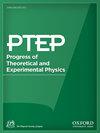QCD 热转变的新视角
IF 8.3
4区 物理与天体物理
Q1 Physics and Astronomy
引用次数: 0
摘要
受近年来针对大 N 计理论提出的部分去抵消图景的启发,我们提出了一种分析和理解 QCD 热相变的新方法。我们通过分析 WHOT-QCD 合作组织在 3 + 1 时空维度上具有上夸克、下夸克和奇异夸克的 SU(3) QCD 的晶格构型,为我们的提议找到了非线性支持。我们发现,波里雅科夫线(热时间圆周围的整体矩阵)在低温下受哈氏随机分布的支配。在较高温度下,与哈尔-随机分布的偏差可以通过特性展开来测量,或者等价于通过由 SU(3) 的各种非琐表示定义的波里雅科夫环的期望值来测量。我们发现,与基本表示相对应的波里雅科夫环和高级表示中的环在不同温度下凝结。这表明存在三个阶段,其中一个中间阶段存在于完全约束阶段和完全去约束阶段之间。我们对中间阶段的识别也得到了瞬子凝聚的支持:通过研究 WHOT-QCD 配置的瞬子数,我们发现瞬子凝聚发生在与我们所识别的完全约束阶段和中间阶段相对应的温度区,而在完全去约束阶段瞬子并不凝聚。我们基于哈尔随机性对约束的描述解释了为什么尽管没有$\mathbb {Z}_3$中心对称,波里雅科夫环仍然是区分QCD中约束和去约束阶段的良好观测指标。本文章由计算机程序翻译,如有差异,请以英文原文为准。
A new perspective on thermal transition in QCD
Motivated by the picture of partial deconfinement developed in recent years for large-N gauge theories, we propose a new way of analyzing and understanding thermal phase transition in QCD. We find nontrivial support for our proposal by analyzing the WHOT-QCD collaboration’s lattice configurations for SU(3) QCD in 3 + 1 spacetime dimensions with up, down, and strange quarks. We find that the Polyakov line (the holonomy matrix around a thermal time circle) is governed by the Haar-random distribution at low temperatures. The deviation from the Haar-random distribution at higher temperatures can be measured via the character expansion, or equivalently, via the expectation values of the Polyakov loop defined by the various nontrivial representations of SU(3). We find that the Polyakov loop corresponding to the fundamental representation and loops in the higher representation condense at different temperatures. This suggests that there are three phases, one intermediate phase existing in between the completely-confined and the completely-deconfined phases. Our identification of the intermediate phase is supported also by the condensation of instantons: by studying the instanton numbers of the WHOT-QCD configurations, we find that the instanton condensation occurs for temperature regimes corresponding to what we identify as the completely-confined and intermediate phases, whereas the instantons do not condense in the completely-deconfined phase. Our characterization of confinement based on the Haar-randomness explains why the Polyakov loop is a good observable to distinguish the confinement and the deconfinement phases in QCD despite the absence of the $\mathbb {Z}_3$ center symmetry.
求助全文
通过发布文献求助,成功后即可免费获取论文全文。
去求助
来源期刊

Progress of Theoretical and Experimental Physics
PHYSICS, MULTIDISCIPLINARY-PHYSICS, PARTICLES & FIELDS
CiteScore
12.00
自引率
5.70%
发文量
148
审稿时长
17 weeks
期刊介绍:
Progress of Theoretical and Experimental Physics (PTEP) is an international journal that publishes articles on theoretical and experimental physics. PTEP is a fully open access, online-only journal published by the Physical Society of Japan.
PTEP is the successor to Progress of Theoretical Physics (PTP), which terminated in December 2012 and merged into PTEP in January 2013.
PTP was founded in 1946 by Hideki Yukawa, the first Japanese Nobel Laureate. PTEP, the successor journal to PTP, has a broader scope than that of PTP covering both theoretical and experimental physics.
PTEP mainly covers areas including particles and fields, nuclear physics, astrophysics and cosmology, beam physics and instrumentation, and general and mathematical physics.
 求助内容:
求助内容: 应助结果提醒方式:
应助结果提醒方式:


